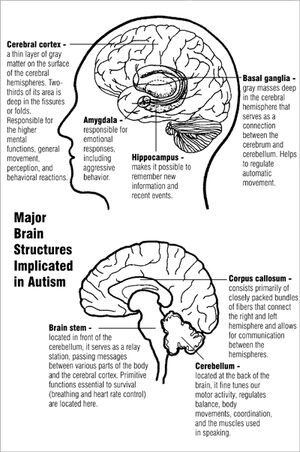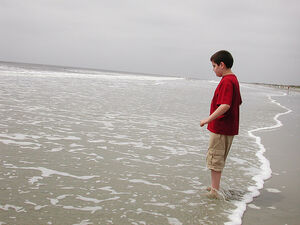
The autism spectrum (also referred to as the autistic spectrum) is a developmental and behavioral condition that results from combinations of characteristically autistic traits, including differences in social interaction, communication, interests, imagination and activities.
All of these traits are found in the neurotypical population, but autistic people tend to have these traits to a greater extent, and to an extent that it is seen as a disability instead of only a personality trait.
In the Diagnostic and Statistical Manual of Mental Disorders (DSM-IV-TR) and the International Statistical Classification of Diseases and Related Health Problems (ICD-10), autism spectrum disorders (ASD) are classified as pervasive developmental disorders (PDD), as opposed to "specific developmental disorders" like dyslexia or dysgraphia. In the DSM-5 the Spectrum was defined under this name alone.
Causes
There is currently no agreement on the causes of autism. However, most researchers believe that there is an underlying genetic element involved in the development of the autistic spectrum. Researchers have studied a wide range of possible genetic and environmental causes. Since autistic individuals are all somewhat different from one another, there are likely multiple "causes" that interact with each other in subtle and complex ways, and thus give slightly differing outcomes in each individual.
In 2001, the National Institutes of Health identified regions of four chromosomes that are linked with autism. [1] One other description of the causes of autism also elaborates this along with a little more comprehensive causes in these words: "The disorder seems to be related to abnormalities in several regions of the brain. Researchers have identified a number of gene defects associated with autism."[2]
Scientists have newly identified a protein gene which they call CACNA1G.[3] It is more common in boys than girls although researchers have no idea why yet. Given that many autistic adults end up having autistic children, a genetic link is likely. It is also believed to be linked to certain structural differences in the brain, supporting the concept of Neurodiversity.
Phil Gluyas believes that the behaviors are inherited from parents who have at least one of the behaviors in the criteria but not all, and that all human beings have at least one behavioral trait.[4]
Other theories involve a connection to immune system dysfunction. Children on the autistic spectrum demonstrated increased frequency of immunologic abnormalities including signs of elevated innate and humoral immunity. This theory has not been substantiated however.
Finding the cause of this condition is a controversial task, as many people on the spectrum and their loved ones worry that this will worsen the already heavy stigma[5] and lead to eugenic abortion.[6][7] The UN "call[s] for caution about enthusiastic attempts to find the causes of autism... through sophisticated but not necessarily ethical research."[8] Advocates argue that money should instead be spend on bettering the lives of autistic people.[9]
Vaccines and mercury have been conclusively proven not to cause autism.[10]
Diagnosing

Every diagnostic appointment with a specialist represents the convergence of three stories:
1) The child, who comes to the appointment with a certain history and in a certain frame of mind, more or less willing to interact;
2) The parents, who come with their own story and their own willingness or ability to relate that story;
3) The diagnostician, who may be a physician, child psychologist or special educator, who also comes with their own training and experience, and the willingness or ability to listen to or elicit that story.
Autism is a clinical diagnosis, based on history and observations. It cannot be confirmed with the certainty of disorders like juvenile diabetes or Down syndrome. There are autism-specific diagnostic tests, but they, too, rely on excellent observations of a child's behaviors at a particular point in time.
Physicians use the diagnostic criteria from the DSM-5.
Educators may use different criteria in order to diagnose "educational autism." This is not a formal diagnosis, which can only be made by a psychologist or psychiatrist.
Autistic traits
Behaviorally, a minimum number of characteristics identify the autism spectrum in combination. These traits can be beneficial for some disciplines like science, mathematics, engineering, and software if they are developed correctly. Some autistic individuals may show a marked proficiency in rote memorization which would help learn the foundation of these subjects; however, the exceptionally good aptitude (in these subjects) of some autistic people may be due to their ability to readily identify patterns and apply them consistently to new situations outside of established knowledge or teaching.
Social differences
- Restricted ability to make friends
- Does not understand others' feelings in some or all situations unless they are fully explained
- Seen as socially awkward
- Indiscriminate social interaction
- Eye contact is inconsistent
- Brief response to questions, or overly detailed
- Socially naive
Language differences
- Odd or monotonous prosody of speech
- Overly formal and pedantic language
- Echolalia
- Pronoun reversal
- Visual thinking sometimes preferred
- Use of rote chunks of language
- Late or no development of spoken language
- Difficulty or inability to translate thoughts into words
- Poor use and understanding of nonverbal communication (i.e., facial expressions and body language)
- Taking things literally
- Delayed reaction to questions and other spoken words
Imaginative differences and repetitive adherence
- Concrete and literal use of language
- Difficulty with figurative language, metaphors and symbolism
- Preference for routine
- Focus on parts rather than whole; detail-oriented; may miss aspects of the whole
- Intensely passionate special interests
Sensory sensitivity
- Hyper- or hyposensitivity of the various senses
- Peculiar clothing and food preferences
- Stimming
- Fine or gross motor discoordination
Helping
There are dedicated facilities for children on the autistic spectrum. However, most children on the high end of the spectrum flourish in a regular education setting with adequate support from parents, teachers, and their classmates through IEP's. Some children at the high end attend special schools dedicated to train and teach children with Autism (and other learning disabilities) - such as the Village Glen School in Los Angeles, California.[11] However, the current mindset is that the Inclusion Model is a best practice for those on the high end of the spectrum.
There are a variety of ways that parents and caregivers can help children with the condition at the high end.
- Children should be encouraged to learn to develop a self-help attitude. This will help the affected children to face life confidently, and face life with more independence.
- Parents should explore the possibilities of getting training and counseling from experts to learn about ways to support the child. The work of autistic writers can offer special insights into what their child experiences and how to help.
- The child should be treated as the part of the family unit, and his/her requirements should also remain in focus alongside the requirements of other family members. This will make the child's position "normal" within the family, and may encourage him/her to participate in the family affairs to the maximum extent possible.
- The child should be able to express their own social goals, and to speak up if something is hurting or troubling them, and not fear contempt for such speech.
- No shortcut method or treatment should be selected for the child. It is always better to have treatments and training programs with long term outlook to guide the long term development of the affected child.
- Apart from the expert advice, it is also necessary for the parents to try to get support, say from members of their community, such as neighbors and friends. There may be support programs available that are sponsored by the local government, hospitals, voluntary organizations and so on. This is also helpful as others may not be aware about the special needs of the affected child. Seeking such support will alert their friends and neighbors about the special needs of the affected child.
- Parents should realize that they will need to advocate for their child to foster acceptance, tolerance and education to the rest of society.
For children who are not at the high end of the spectrum, there are options in early interventions to raise the child's functioning level. However these interventions do not follow a pattern and are very much hit and miss.
Spectrum

The word spectrum conjures the notion of a continuum, such as a rectangle that transitions from white to black, or high to low functioning. This would be a serious oversimplification.
Autism has many different potential symptoms. Each autistic person may experience each symptom differently, and may not not have all of the symptoms. Autism has been compared to...
- An ice cream bar with various toppings
- A complex color wheel
- A field
Autism organizations may use rainbows to symbolize the diversity of people on the spectrum and hope for acceptance and support.
When comparing the Spectrum to the neurotypical community, Autism can be seen in contrast in the following ways;
- An aeroplane and a helicopter
- Computers operating with Windows and Linux
External links
- CDC's "Learn the Signs. Act Early.” campaign - Information for parents on early childhood development and developmental disabilities such as autism
- ASAN - The Autistic Self Advocacy Network
- ASAN: About Autism
- Autistic Spectrum - A resource for High functioning Autism and Aspergers Syndrome
- Fact sheets on Autism & Asperger's: diagnosis, interventions, causes & behavior management
- Wrong Planet - A web community for those on the autism spectrum with an emphasis on support and advocacy.
- Autism Spectrum Disorders (Pervasive Developmental Disorders)
- Diagnosis, Education Advice, and Health Issues
- Weird Not Stupid - A website created from the perspective of a person who has two siblings who are on the Autism Spectrum with the goal of giving information to anybody who is seeking it.
- Autism Key - Established by and for parents of children with autism spectrum disorders. Offers research, support, news & media links and message boards.
- Autism Spectrum Disorders from ScienceDaily - Latest research news on autism spectrum disorders. Includes searchable archives.
References
- ↑ NIH: Researchers Find New Insights Into the Genetic Foundations of Autism
- ↑ Mayo Clinic - Autism: cause
- ↑ https://gene.sfari.org/GeneDetail/Cacna1g SFARI Gene - Autism Database
- ↑ http://www.philgluyas.com/as/genetic.htm Article: Autism is Genetic in Origin
- ↑ http://everydayfeminism.com/2015/06/pushing-autism-cure-messed-up/ Everyday Feminism: We Don't Need a Cure for Autism - And Pushing One Is Really Messed Up
- ↑ http://thautcast.com/drupal5/content/get-real-autism-speaks-mostly-about-eugenics TheAutcast: Get Real - Autism Speaks is Mostly About Eugenics
- ↑ https://tomplastow.wordpress.com/2014/02/09/dear-autism-parents-we-dont-want-to-be-cured-2/ Dear "Autism Parents," We Don't Want To Be Cured
- ↑ http://www.ohchr.org/EN/NewsEvents/Pages/DisplayNews.aspx?NewsID=15787 Discrimination against autistic persons, the rule rather than the exception – UN rights experts
- ↑ http://www.thedailybeast.com/articles/2015/02/25/they-don-t-want-an-autism-cure.html The Daily Beast: They Don't Want an Autism Cure
- ↑ Autism Science Foundation: Autism and Vaccines
- ↑ http://www.villageglen.org/about/ About Village Glen School
Template:Wikipedia
